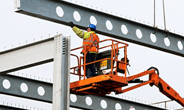Steel Markets

AGC: Spiking Materials Prices Hinder Recovery of Construction Jobs
Written by Tim Triplett
March 8, 2022
While 29 states now employ more construction workers than before the pandemic, construction employment is still below February 2020 levels in 21 states and D.C., underscoring how spiking materials prices and tight labor markets are undermining the sector’s recovery, said the Associated General Contractors of America.
![]() “Employment has risen in most of the nation over the past year, but contractors are having an increasingly hard time finding all the workers they need as unemployment hits record lows in more states,” said Ken Simonson, the trade association’s chief economist. “The scramble for workers is likely to drive wages and overtime costs even higher at the same time rising materials prices are cutting into already tight margins.”
“Employment has risen in most of the nation over the past year, but contractors are having an increasingly hard time finding all the workers they need as unemployment hits record lows in more states,” said Ken Simonson, the trade association’s chief economist. “The scramble for workers is likely to drive wages and overtime costs even higher at the same time rising materials prices are cutting into already tight margins.”
Citing federal employment data from February 2020 through January 2022, AGC reported New York shed the most construction jobs in the period (-32,000 jobs, -7.8%), followed by Texas (-29,400 jobs, -3.8%), California (-28,600 jobs, -3.1%), and Pennsylvania (-10,500 jobs, -4.0%). The largest percentage losses were in New York, North Dakota (-7.8%, 2,200 jobs), Oklahoma (-6.7%, -5,500 jobs), and New Mexico (-5.8%, -3,000 jobs).
Utah added the most construction jobs since February 2020 (10,400 jobs, 9.1%), followed by Indiana (8,600 jobs, 5.8%), and Missouri (7,100 jobs, 5.5%). The largest percentage gains were in Montana (11.4%, 3,500 jobs), followed by Idaho (10%, 5,500 jobs), and Utah.
From December to January, construction employment decreased in 19 states and D.C., increased in 27 and was unchanged in Delaware, Idaho, Nebraska and South Carolina. Illinois lost the most jobs (-7,100 jobs, -3.1%), followed by Texas (-5,000 jobs, -0.7%) and New York (-2,900 jobs, -0.8%). Illinois also had largest percentage decline, followed by New Mexico (-2.2%, -1,100 jobs), Louisiana (-2.1%, -2,800 jobs), and Rhode Island (-2.0%, -400 jobs).
North Carolina added the most construction jobs between December and January (2,900 jobs, 1.2%), followed by Ohio (2,800 jobs, 1.2%) and Mississippi (2,100 jobs, 4.5%). Mississippi had the largest percentage gain, followed by Maine (2.2%, 700 jobs) and Vermont (2.0%, 300 jobs).
Association executives said that many contractors are struggling to cope with rapidly rising prices for a broad range of key construction materials. They cautioned that anyone procuring construction services should expect to pay more as costs for steel, diesel and many other products rise rapidly. They also urged public officials to look for ways to help construction firms offset losses from jumping materials prices on existing projects.
“Construction firms are going to have to pass along the rising materials prices to remain successful,” said Stephen E. Sandherr, the association’s chief executive officer. “And construction firms should not be punished for failing to foresee a Russian invasion, spiking oil prices and soaring inflation when preparing public works bids.”

Tim Triplett
Read more from Tim TriplettLatest in Steel Markets

CMC looks beyond Arizona micro-mill woes to long-term viability of construction mart
Despite the economic and geopolitical upheaval of the last five years, CMC President and CEO Peter Matt points out that the construction market has been an essential element of the way forward.

US importers face stricter rules under revamped S232 tariffs
“CBP expects full compliance from the trade community for accurate reporting and payment of the additional duties. CBP will take enforcement action on non-compliance," the agency said in a March 7 bulletin.

Steel exports rebound in January
US steel exports recovered to a five-month high in January after having fallen to a two-year low in December. This growth follows four consecutive months of declining exports.

Construction spending drops marginally in January
Construction spending edged down slightly in January, slipping for the first time in four months. The US Census Bureau estimated spending at a seasonally adjusted annual rate of $2,196 billion in January, down 0.2% from December’s downward revised rate. The January figure is 3.3% higher than a year ago. January’s result, despite the slight erosion, […]

HVAC equipment shipments slow in December but strong annually
Shipments of heating and cooling equipment in the US fell to an 11-month low in December, according to the latest data released by the Air-Conditioning, Heating, and Refrigeration Institute (AHRI).
